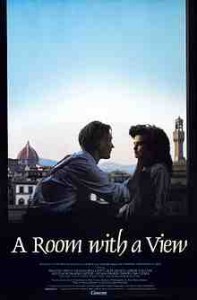Favourite film: A Room with a View
Favourite film: A Room with a View
Favourite film: A Room with a View
-
Hannah
-
Hannah
 When I’m writing a novel, I like to immerse myself so far as is possible in the culture and time in which the story is set. For my most recently published novel, The Echoes of Love, that meant enjoying Italian culture – watching films, reading books and listening to music – but also broadening out to popular culture of the era (the turn of the millennium) and to non-Italian works that are inspired by the Italian setting.
When I’m writing a novel, I like to immerse myself so far as is possible in the culture and time in which the story is set. For my most recently published novel, The Echoes of Love, that meant enjoying Italian culture – watching films, reading books and listening to music – but also broadening out to popular culture of the era (the turn of the millennium) and to non-Italian works that are inspired by the Italian setting.
One of the films I most enjoyed re-watching after many years was the Merchant-Ivory adaptation of EM Forster’sA Room with a View. Have you seen the film? If, like me, you’re a romantic, and you like period dramas, then it’s beautiful – but it’s worth watching for the Italian setting alone.
The story, set in the Edwardian era, follows the developing love between two young people: Lucy Honeychurch (what a name!) and George Emerson. Lucy is limping along in a restrictive upper-class world still rife with Victorian ideals; George represents forward-thinking ideals and is deeply attractive for his free spirit. A kiss – such a kiss – ensues, but how can Lucy cast off the system of rigidity in which she dwells and accept George’s advances? It is more fitting, surely, to marry straight-laced, wealthy, respectable Cecil. Fitting, but was there ever a man more lacking in passion? Does passion matter? What is love, and does Lucy have the right to claim it? These questions, and more, lie at the heart of this evocative love story. I won’t spoil the ending, but suffice it to say that Lucy finds that room with a view that she needs – and don’t we all need one!
The film won widespread critical acclaim, and multiple awards, including Academy Awards, Golden Globes and BAFTAs.I think what I love most about the film is how it encapsulates the stirring beauty of the Italian landscape; how the romanticism of Italy can affect a foreigner to the land. This is a theme I explore in my own novel, The Echoes of Love, whose characters are also English and find love in Italy – in Tuscany, ultimately: location for Forster’s love story. Take a look at this clip and you’ll see how the setting – the breathtaking countryside; the moving Puccini aria – creates romance, demands romance.
As George says: ‘[t]here is something in the Italian landscape which inclines even the most stolid to romance’. And I would argue that there is something in this film, this particular adaptation of the Forster classic, that could incline even the most stolid to romance too.